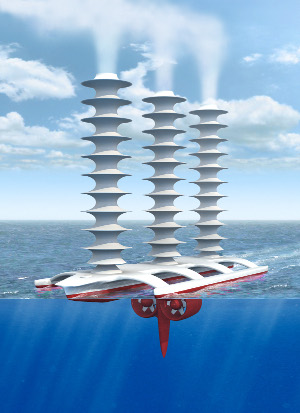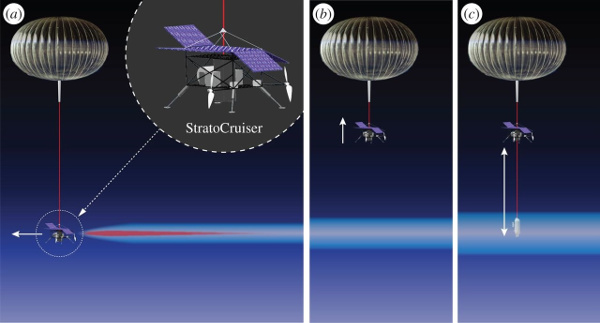
Geoengineering’s dilemma
What comes first, research or governance?
Geoengineering may be the most controversial technology that doesn’t yet exist. Also called climate engineering, it’s a group of proposed strategies with the potential to counteract climate change by altering climate on a global scale. Critics assert that geoengineering could cause tremendous environmental harm and distract from established efforts to reduce greenhouse gas emissions. However, as nations have struggled to reduce their emissions, geoengineering may be the only way to meet the internationally agreed upon target of keeping the global temperature rise well below 2° C.
Perhaps because geoengineering does not yet exist on any significant scale, there are no national laws or international treaties restricting or enabling its use. Any country could attempt a geoengineering scheme with Earth-changing effects within its own borders or the global commons, and there is no oversight to guide the necessary research into how—and, more importantly, if—nations should use this technology. This lack of governance and research creates a chicken-or-egg conundrum. Scientists need better governance to support responsible geoengineering research, but efforts to develop an international governance system are stalled by resistance to the poorly defined technology.
To break this stalemate, Sikina Jinnah, UC Santa Cruz associate professor of politics, thinks that governance and research need to ensue simultaneously. “We shouldn’t hold off on initiating governance mechanisms until we know if these technologies are viable or not,” she said. “Governance and research need to inform each other—neither should evolve in a vacuum.” Jinnah and colleagues are proposing an initial path forward using a polycentric approach that taps into existing international institutions at multiple levels. Her research suggests that public discussion and decisions on geoengineering can be guided in the near-term using governance systems that already exist, not necessarily the ones that ultimately may be needed if large-scale geoengineering becomes a reality.
Jinnah has spent almost two decades researching how international institutions respond to environmental problems. In 2014, she became interested in the emerging field of geoengineering governance as an assistant professor of international relations at American University in Washington, D.C. She quickly established her standing in the field and was invited by her American University colleague Simon Nicholson, assistant professor and director of the Global Environmental Politics Program, to join the academic working group for his research and public policy initiative, the Forum for Climate Engineering Assessment. The working group attempts to bridge academic and policy conversations on geoengineering governance and will publish their first comprehensive policy recommendations later this year.
Geoengineering attracted Jinnah for both its enormous potential and incredible risks. “It’s the most alive space I’ve ever worked in,” she said. “It’s not just a banal academic topic. People who are engaged in this have strong and deep feelings about what they’re doing and what it means for present and future generations.” In 2017 she received an Andrew Carnegie Fellowship to further her work on geoengineering governance.
Climate control
Geoengineering is not a new idea, but it is receiving increased attention as the debate over what to do about climate change intensifies. Its roots lie in cloud-seeding operations from the 1950s designed to bring more rain to farmlands and military attempts to flood the Ho Chi Minh Trail in Vietnam in the 1960s. Nobel Prize–winning atmospheric chemist Paul Crutzen brought the idea to the forefront in 2006 when he proposed a form of geoengineering as an antidote to global warming. In 2009, The Royal Society amplified that message by releasing a report on geoengineering aimed at policymakers.
Geoengineering technologies roughly fall into two camps: solar radiation management (SRM) and carbon dioxide removal (CDR). SRM approaches would attempt to reflect more sunlight back into space, in effect dimming the sun. One strategy, called stratospheric aerosol injection, would mimic the effects of a volcanic eruption by using an airplane or balloon to spray particles into the stratosphere to block sunlight. A second strategy, called marine cloud brightening, would seed the formation of brighter, more reflective clouds. The effect would be the same as the long strings of clouds called “ship tracks” that form from boat exhaust, but on a far larger scale.
Thus far, scientists have limited SRM research primarily to theoretical modeling. While most models predict that SRM could rapidly and cheaply lower global temperatures, some of those same models predict that the technology would cause significant changes to global rainfall patterns that could affect agriculture. SRM could buy humanity more time to reduce emissions, thus avoiding the worst effects of climate change, but it does nothing to address greenhouse gas emissions or ocean acidification. Also, if SRM begins without concurrent aggressive reductions to atmospheric carbon dioxide, any interruption could cause global temperatures to jump up to what they would have been without the intervention, which could have brutal impacts.
In the second camp of geoengineering, CDR comprises a range of technologies that remove and sequester carbon dioxide from the atmosphere. CDR includes large-scale tree planting and biochar—the burial of charred organic waste for long-term carbon storage—as well as the more extreme idea of fertilizing the ocean with iron so that phytoplankton blooms soak up atmospheric carbon dioxide (see sidebar). Companies are also developing machines that suck carbon dioxide directly from the air and a system called bioenergy with carbon capture and storage (BECCS), where power plants would burn biomass to generate energy and then pump the resulting carbon dioxide underground. These options are generally more appealing to the public because they feel more contained than SRM. However, these strategies would have to be greatly scaled up and widely adopted to have a global impact, an effort likely to carry a hefty price tag.
Though most of these technologies remain closer to science fiction than applied science, CDR has recently assumed a more prominent position in the climate change governance discussion. In the U.N.’s Intergovernmental Panel on Climate Change (IPCC) Fifth Assessment Report from 2014, a majority of presented scenarios depend on BECCS to reach negative carbon emissions by mid-century and to keep the global temperature increase below 2° C. The 2015 Paris Agreement, which provides a framework for individual countries to set their own goals to reduce carbon emissions, does not mention geoengineering but also has called for a net negative carbon economy after 2050, a goal that some argue may be impossible to reach without CDR technologies. “Suddenly something that wasn’t really part of the international climate change conversation is very much a part of the mix because these models, which the world depends on for its policy decisions, have started to incorporate them,” said Nicholson. In addition, if its withdrawal from the Paris Agreement means that the U.S. fails to deliver on its greenhouse gas reduction commitments, this could increase demand for geoengineering solutions.

No rules
Despite emerging awareness of geoengineering’s potentially pivotal role, how and if it should be applied are questions that remain largely unaddressed. “There are no existing laws or institutions at the international level to regulate or control or do anything about geoengineering,” said Edward Parson, professor of environmental law at UC Los Angeles. He noted that parties to the Convention on Biological Diversity have requested that participating countries not employ geoengineering until research has adequately considered its environmental, economic, and social impacts, but the decision is nonbinding. And the IPCC is simply a scientific assessment body and the U.N. Framework Convention on Climate Change (UNFCCC), the international environmental treaty, whose 2015 annual meeting produced the Paris Agreement, does not address geoengineering. If it did, it would not have the administrative capacity to regulate it, said Parson. “What it would take to effectively govern geoengineering at the international level is very much an open question.”

One emerging international governance mechanism is a code of conduct put forth by Anna-Maria Hubert, assistant professor of law at the University of Calgary. The code provides guidance for responsible geoengineering research with the objectives of minimizing environmental harm, enhancing legitimacy, and creating a better understanding of the technologies’ efficacy and risks. Hubert’s code is an important contribution, but further governance mechanisms are also needed, Jinnah said.
In addition to the absence of governance, there is the problem of “moral hazard,” the concern that pursuing these technologies could divert institutional resources needed to reduce emissions. “Even thinking about geoengineering, let alone deploying it, could have adverse effects on mitigation efforts, because it creates this idea of a technological fix that maybe provides a get-out-of-jail free card for fossil fuel companies,” said Rob Bellamy, a University of Oxford research fellow with a particular interest in how public participation affects issues related to climate change, including geoengineering governance.
Several major environmental nongovernmental organizations (NGOs) have taken a precautionary stance against geoengineering, due to the moral hazard and environmental concerns, said Jinnah. This view has kept NGOs from having a meaningful voice in the geoengineering discussion. Through the Forum for Climate Engineering Assessment, Jinnah, Nicholson, and others are trying to change that. “We’re working to help NGOs and policymakers understand the existing information so we can have a real and meaningful conversation,” said Nicholson.
Outlook cloudy
Two impending SRM field experiments highlight the need for greater governance. Neither experiment will have any impact on the climate, but some fear that outdoor experiments could initiate a slippery slope toward reliance on such technological fixes to address climate change, said Jinnah.
SCoPEx, which stands for Stratospheric Controlled Perturbation Experiment, involves sending a balloon more than 12 miles into the atmosphere to spray two pounds of ice or limestone dust. In a later stage, a small amount of sulfur-containing aerosols may be released. Harvard University researchers Frank Keutsch, professor of chemistry and chemical biology, and David Keith, professor of applied physics, lead the Harvard-funded project, which aims to show how the aerosols move and interact with gases in the atmosphere. The results will inform future models of the potential risks and effectiveness of large-scale spraying.

“In the grander scheme of things, this is a relatively benign project in terms of environmental impact,” said Jinnah. “That said, a lot of people are up in arms about it because some think of it as opening the door to more invasive types of field experimentation.”
Equally benign is the Marine Cloud Brightening Project, proposed by Thomas Ackerman, professor of atmospheric sciences at the University of Washington in Seattle. Ackerman’s group wants to spray saltwater droplets to seed cloud formation over a small area of Monterey Bay, just down the road from UCSC at Moss Landing. The experiment would show the size and quantity of aerosols needed to form brighter clouds, but has not yet received funding.
Experts estimate that viable SRM technologies could be ready in about 20 years at a cost of $1 billion to $10 billion U.S. dollars annually to deploy at a scale that could impact global warming. This relatively low price tag means that a single country or even a billionaire with a balloon could initiate SRM with worldwide consequences. “SRM would have trans-boundary impacts,” said Jinnah. “It has to involve cooperation between different countries because it’s not going to be contained within the boundaries of a single country.”
In an ideal world, representatives from each country would gather to negotiate a treaty regarding SRM and other geoengineering approaches. However, it’s unrealistic to think that this will happen in the near-term, said Jinnah. “There’s no political appetite for it right now.”
A last resort
In lieu of a new, international, top-down agreement, Jinnah, Nicholson, and colleague Alexander Gillespie, professor of international law at the University of Waikato in New Zealand, propose three concrete policy recommendations as part of a polycentric approach to governing SRM, in which multiple existing institutions can take on different roles to govern geoengineering technologies.
A key part of this approach is to increase the transparency of SRM research. “I advocate strongly for some sort of transparency mechanism so that people who are interested in being engaged in these discussions have a pathway through which to understand what’s happening,” said Jinnah. Both Keith and Ackerman maintain highly informative websites on their proposed SRM experiments, but an international clearinghouse might better inform policy decisions, create funding opportunities, and help researchers coordinate their activities.

Jinnah and her colleagues suggest that the World Meteorological Organization (WMO) could develop such a clearinghouse, as it not only has a mandate as an agency of the U.N., but already facilitates worldwide weather monitoring and the sharing of information, expertise, and resources for weather, climate, and hydrology research. Alternatively, the U.N. Educational, Scientific and Cultural Organization (UNESCO) could fill this niche. UNESCO helps researchers coordinate their efforts and advises countries on science policy, especially with regard to emerging technologies. Its Global Ethics Observatory, a database of researchers, institutions, codes of conduct, and resources related to scientific ethics, could be expanded to include SRM research.
The second recommendation from Jinnah and her colleagues would establish a global forum that unites policymakers, NGOs, and other stakeholders. This forum, which could be organized through U.N. Environment, would help advise governments and guide public engagement on SRM. The role of U.N. Environment is to coordinate environmental activities and sustainability efforts through the U.N. system. The program also has experience in advancing public engagement, which could help legitimize research, leading to greater funding and more comprehensive studies. Such engagement efforts have been conducted by researchers in the United Kingdom, Germany, and the U.S., but it will be important to engage stakeholders worldwide.
Finally, Jinnah and colleagues recommend that SRM assessment be included in the next “global stocktake” under the Paris Agreement, due out in 2023. Scheduled every five years (beginning with an initial exercise in 2018), the global stocktake reviews global progress toward climate change goals. As an existing vehicle, it could lend transparency to country-level activities regarding geoengineering research.
While these recommendations do not constitute a comprehensive governance plan for geoengineering, they represent a good start to cracking the chicken-or-egg dilemma. With at least a rudimentary governance framework in place, important research can be encouraged to help inform decisions about geoengineering’s possible role in managing climate change. Mid-century, when the IPCC estimates that humans must soak up as much carbon dioxide as they emit to stay below a 2° C increase, is just three decades away.
“The possibility of this being a last ditch resort for solving climate change if we find ourselves in a terrible situation is a big part of why I’m engaged,” said Jinnah. “There’s so much at stake.”

